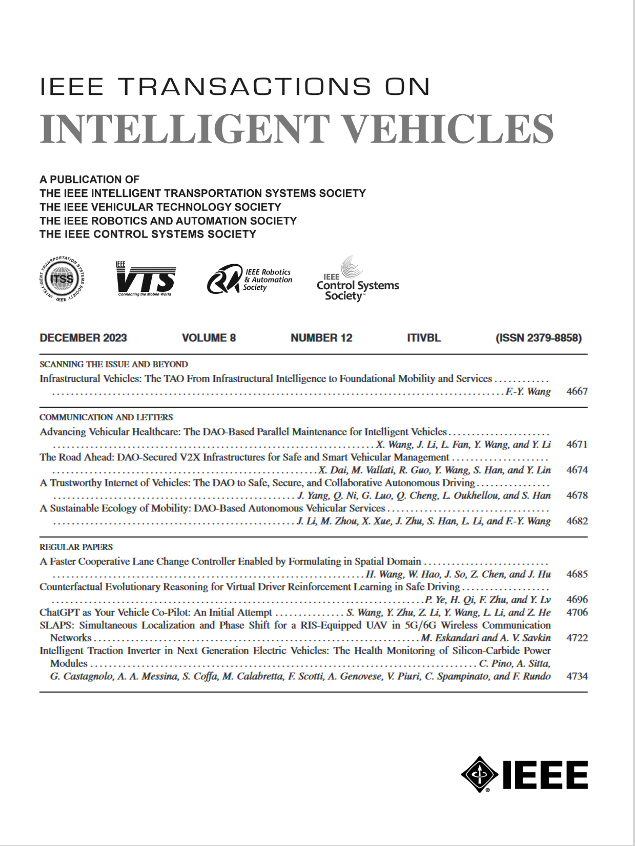Anti-Jamming Attack Mixed Strategy for Formation Tracking Control via Game-Theoretical Reinforcement Learning
IF 14.3
1区 工程技术
Q1 COMPUTER SCIENCE, ARTIFICIAL INTELLIGENCE
引用次数: 0
Abstract
Communication plays a role in multi-UAV to perform formation tracking missions. In complex environments, UAV communication is often subject to jamming attacks, affecting the formation process. Therefore, studying the formation tracking control problem in jamming attacks is of great significance. Typically, the actions of the UAV consist of two fundamental modules: mobility strategy and communication strategy. In this paper, we design an anti-jamming attack mixed strategy for formation tracking control of the multi-UAV system. In practical scenarios, multi-UAV systems not only require the accomplishment of formation maneuvers but also necessitate effective mitigation of jamming attacks caused by other UAVs. Therefore, we suppose there are three types of UAVs: leaders, followers, and jammers. To illustrate the interactions between multiple UAVs of the formation tracking process under jamming attack, a three-layer Stackelberg game is constructed. Leaders and followers need to resist interference from jammers during the formation tracking process with a leader-follower structure. Leaders and followers achieve formation tracking through cooperation. The interactions between jammers and the other UAVs form a non-cooperative game. Moreover, the utility functions of a mixed strategy, which contain mobility and communication strategies, are designed for the three-layer Stackelberg game. The Stackelberg-Nash equilibrium of the designed game model is proven to exist. For seeking the Stackelberg-Nash equilibrium, a tri-level actor-critic (Tri-AC) reinforcement learning algorithm is designed. The convergence of the designed algorithm is also proved theoretically. Finally, the effectiveness of the designed method is verified by various simulation experiments.基于博弈论强化学习的编队跟踪控制抗干扰攻击混合策略
通信在多无人机编队跟踪任务中发挥着重要作用。在复杂环境下,无人机通信经常受到干扰攻击,影响编队过程。因此,研究干扰攻击中的编队跟踪控制问题具有重要意义。通常,无人机的行动由两个基本模块组成:机动策略和通信策略。针对多无人机编队跟踪控制问题,设计了一种抗干扰攻击混合策略。在实际场景中,多无人机系统不仅需要完成编队机动,而且需要有效地减缓其他无人机的干扰攻击。因此,我们假设有三种类型的无人机:领导者,追随者和干扰者。为了说明多架无人机在干扰攻击下编队跟踪过程中的相互作用,构造了一个三层Stackelberg博弈模型。在leader-follower结构的编队跟踪过程中,leader和follower需要抵抗干扰者的干扰。领导者和追随者通过合作实现队形跟踪。干扰机与其他无人机之间的相互作用形成非合作博弈。针对三层Stackelberg博弈,设计了包含移动策略和通信策略的混合策略效用函数。证明了所设计的博弈模型的Stackelberg-Nash均衡的存在。为了寻求Stackelberg-Nash均衡,设计了一种三层次行为者-批评家(triac)强化学习算法。从理论上证明了所设计算法的收敛性。最后,通过各种仿真实验验证了所设计方法的有效性。
本文章由计算机程序翻译,如有差异,请以英文原文为准。
求助全文
约1分钟内获得全文
求助全文
来源期刊

IEEE Transactions on Intelligent Vehicles
Mathematics-Control and Optimization
CiteScore
12.10
自引率
13.40%
发文量
177
期刊介绍:
The IEEE Transactions on Intelligent Vehicles (T-IV) is a premier platform for publishing peer-reviewed articles that present innovative research concepts, application results, significant theoretical findings, and application case studies in the field of intelligent vehicles. With a particular emphasis on automated vehicles within roadway environments, T-IV aims to raise awareness of pressing research and application challenges.
Our focus is on providing critical information to the intelligent vehicle community, serving as a dissemination vehicle for IEEE ITS Society members and others interested in learning about the state-of-the-art developments and progress in research and applications related to intelligent vehicles. Join us in advancing knowledge and innovation in this dynamic field.
 求助内容:
求助内容: 应助结果提醒方式:
应助结果提醒方式:


